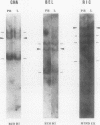Abstract
Sézary syndrome is a cutaneous T cell lymphoma characterized by infiltration of the skin by CD4+ cells. These cells generally respond poorly to mitogens and T cell activators. We have studied the action of IL1 to IL4, IL6, and IL7 on the proliferation of Sézary cells from 12 patients. With the exception of IL2 and IL7, the cytokines studied had no proliferative effect on these cells. Whereas IL2 had only a low proliferative capacity (two- to threefold increase) on peripheral blood mononuclear cells, recombinant IL7 constantly induced a very significant (3-40-fold increase) proliferative response, and was used successfully to generate cell lines in three out of eight cases. Growth of Sézary cell lines was shown to be strictly dependent on IL7, and after 2-5 wk of culture presented a switch to a homogeneous phenotype CD3+4+8-7- (except for one line that remained CD7+), with a typical morphology of Sézary cells. Their tumoral origin was demonstrated by the expression of the same T cell receptor-beta gene rearrangement as the patients' T cells. Importantly, cultured normal epidermal keratinocyte supernatants could support the growth of our Sézary lines. Furthermore, the proliferative activity contained in these supernatants was completely blocked by a monoclonal anti-IL7 antibody. These results suggest that IL7 may, therefore, represent an important cytokine in the physiopathology of cutaneous T cell lymphoma.
Full text
PDF
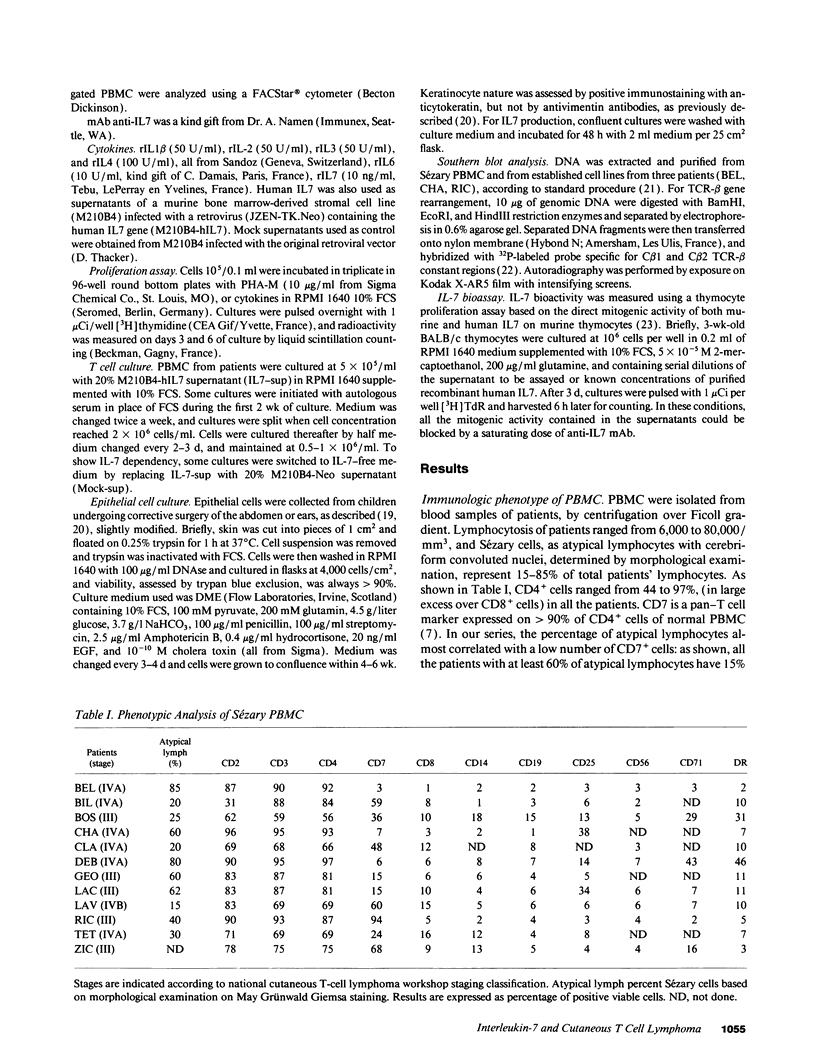
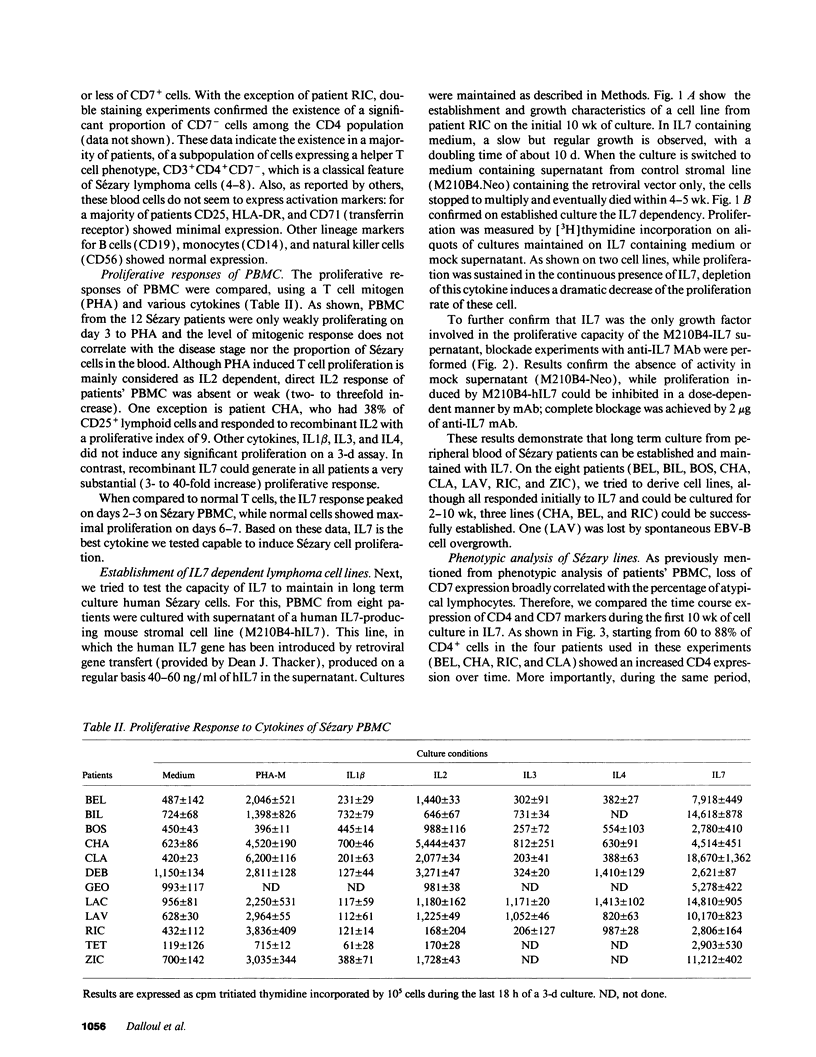
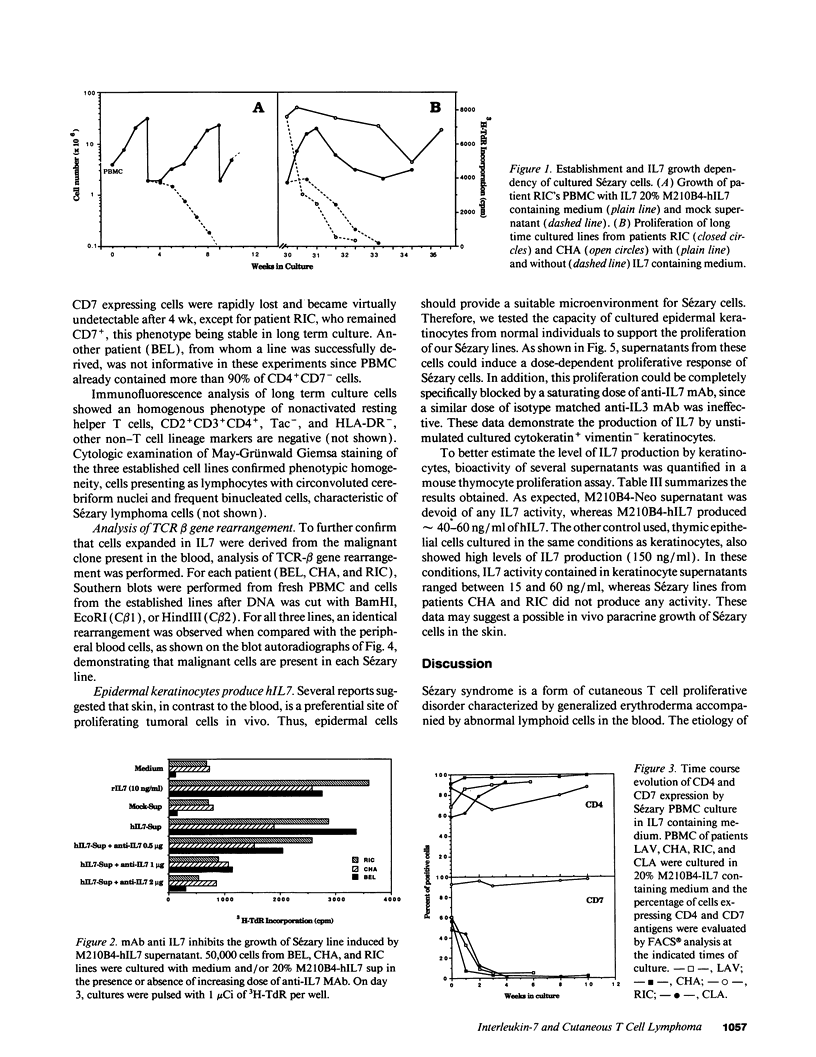
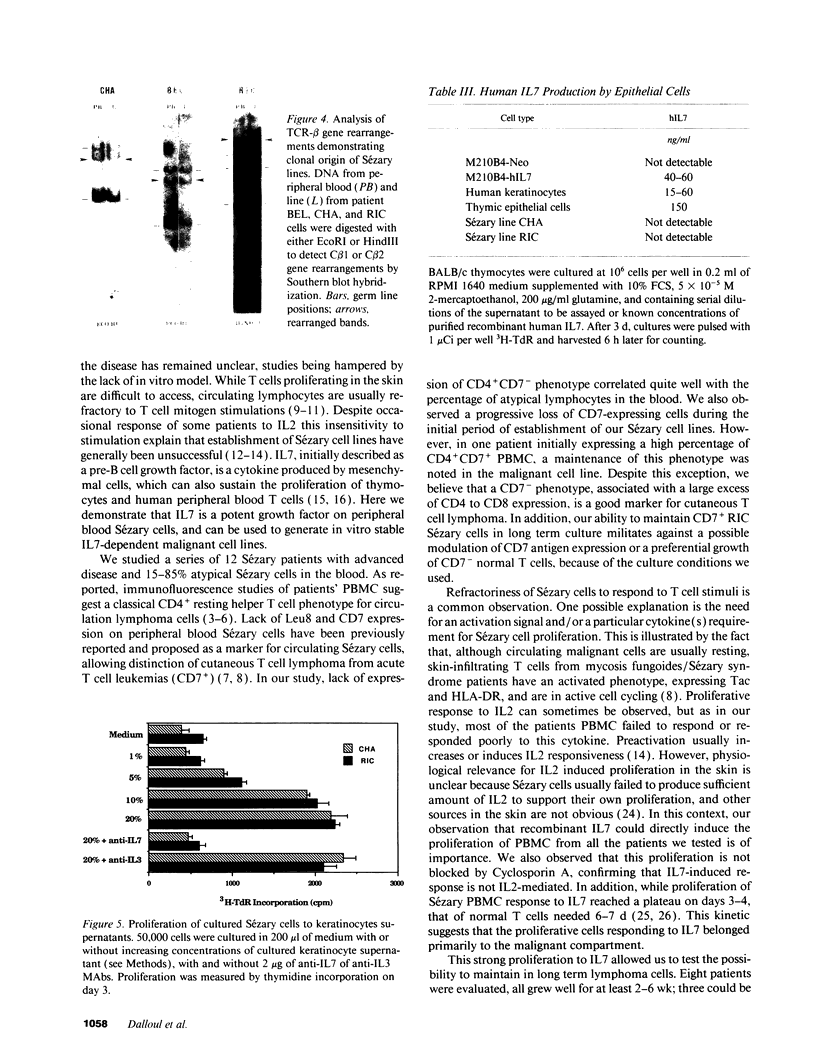
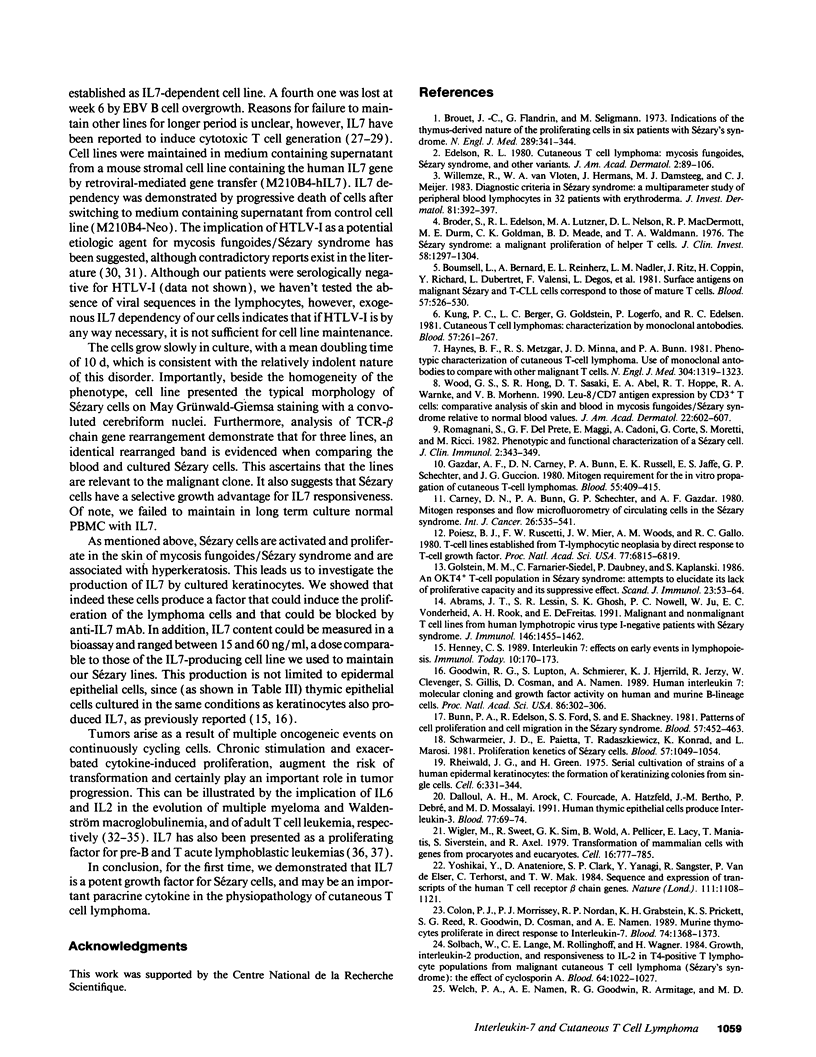
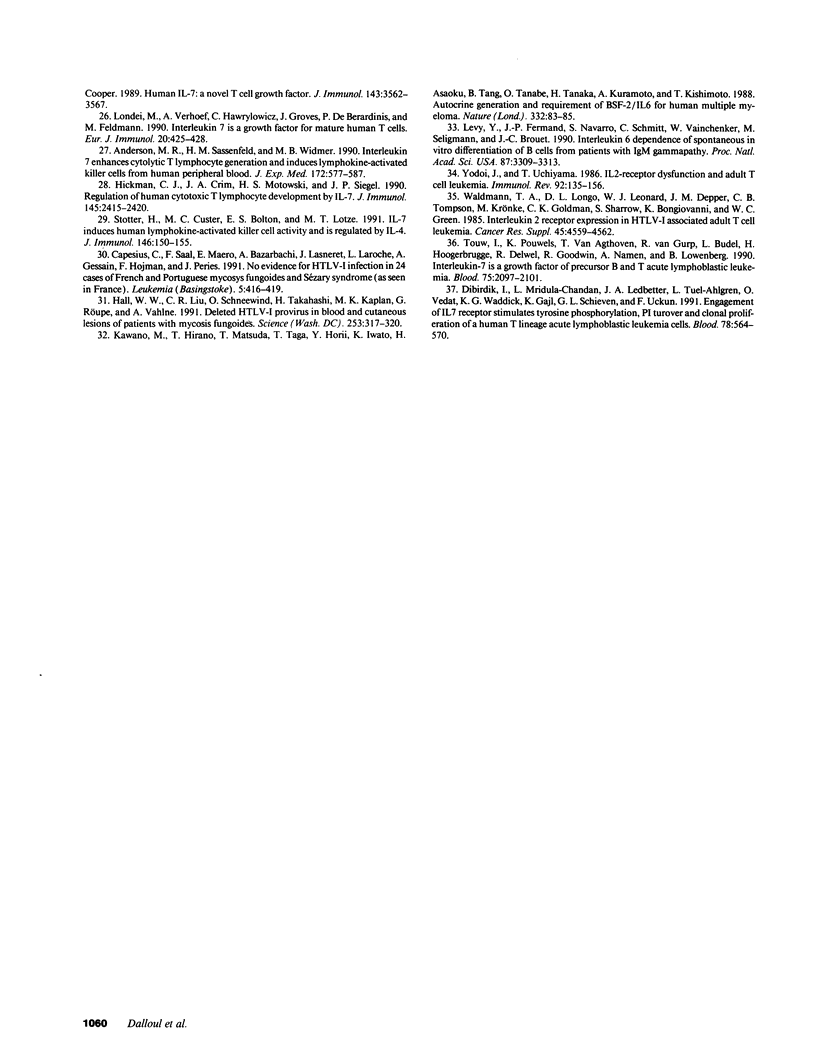
Images in this article
Selected References
These references are in PubMed. This may not be the complete list of references from this article.
- Abrams J. T., Lessin S. R., Ghosh S. K., Nowell P. C., Ju W., Vonderheid E. C., Rook A. H., DeFreitas E. Malignant and nonmalignant T cell lines from human T cell lymphotropic virus type I-negative patients with Sézary syndrome. J Immunol. 1991 Mar 1;146(5):1455–1462. [PubMed] [Google Scholar]
- Alderson M. R., Sassenfeld H. M., Widmer M. B. Interleukin 7 enhances cytolytic T lymphocyte generation and induces lymphokine-activated killer cells from human peripheral blood. J Exp Med. 1990 Aug 1;172(2):577–587. doi: 10.1084/jem.172.2.577. [DOI] [PMC free article] [PubMed] [Google Scholar]
- Boumsell L., Bernard A., Reinherz E. L., Nadler L. M., Ritz J., Coppin H., Richard Y., Dubertret L., Valensi F., Degos L. Surface antigens on malignant Sézary and T-CLL cells correspond to those of mature T cells. Blood. 1981 Mar;57(3):526–530. [PubMed] [Google Scholar]
- Broder S., Edelson R. L., Lutzner M. A., Nelson D. L., MacDermott R. P., Durm M. E., Goldman C. K., Meade B. D., Waldmann T. A. The Sézary syndrome: a malignant proliferation of helper T cells. J Clin Invest. 1976 Dec;58(6):1297–1306. doi: 10.1172/JCI108585. [DOI] [PMC free article] [PubMed] [Google Scholar]
- Brouet J. C., Flandrin G., Seligmann M. Indications of the thymus-derived nature of the proliferating cells in six patients with Sézary's syndrome. N Engl J Med. 1973 Aug 16;289(7):341–344. doi: 10.1056/NEJM197308162890703. [DOI] [PubMed] [Google Scholar]
- Bunn P. A., Jr, Edelson R., Ford S. S., Shackney S. E. Patterns of cell proliferation and cell migration in the Sézary syndrome. Blood. 1981 Mar;57(3):452–463. [PubMed] [Google Scholar]
- Capésius C., Saal F., Maero E., Bazarbachi A., Lasneret J., Laroche L., Gessain A., Hojman F., Périés J. No evidence for HTLV-I infection in 24 cases of French and Portuguese mycosis fungoïdes and Sezary syndrome (as seen in France). Leukemia. 1991 May;5(5):416–419. [PubMed] [Google Scholar]
- Carney D. N., Bunn P. A., Jr, Schechter G. P., Gazdar A. F. Lymphocyte transformation in patients with cutaneous T-cell lymphomas. Int J Cancer. 1980 Nov 15;26(5):535–542. doi: 10.1002/ijc.2910260503. [DOI] [PubMed] [Google Scholar]
- Conlon P. J., Morrissey P. J., Nordan R. P., Grabstein K. H., Prickett K. S., Reed S. G., Goodwin R., Cosman D., Namen A. E. Murine thymocytes proliferate in direct response to interleukin-7. Blood. 1989 Sep;74(4):1368–1373. [PubMed] [Google Scholar]
- Dalloul A. H., Arock M., Fourcade C., Hatzfeld A., Bertho J. M., Debré P., Mossalayi M. D. Human thymic epithelial cells produce interleukin-3. Blood. 1991 Jan 1;77(1):69–74. [PubMed] [Google Scholar]
- Dibirdik I., Langlie M. C., Ledbetter J. A., Tuel-Ahlgren L., Obuz V., Waddick K. G., Gajl-Peczalska K., Schieven G. L., Uckun F. M. Engagement of interleukin-7 receptor stimulates tyrosine phosphorylation, phosphoinositide turnover, and clonal proliferation of human T-lineage acute lymphoblastic leukemia cells. Blood. 1991 Aug 1;78(3):564–570. [PubMed] [Google Scholar]
- Edelson R. L. Cutaneous T cell lymphoma: mycosis fungoides, Sézary syndrome, and other variants. J Am Acad Dermatol. 1980 Feb;2(2):89–106. doi: 10.1016/s0190-9622(80)80385-9. [DOI] [PubMed] [Google Scholar]
- Gazdar A. F., Carney D. N., Bunn P. A., Russell E. K., Jaffe E. S., Schechter G. P., Guccion J. G. Mitogen requirements for the in vitro propagation of cutaneous T-cell lymphomas. Blood. 1980 Mar;55(3):409–417. [PubMed] [Google Scholar]
- Golstein M. M., Farnarier-Seidel C., Daubney P., Kaplanski S. An OKT4+ T-cell population in Sézary syndrome: attempts to elucidate its lack of proliferative capacity and its suppressive effect. Scand J Immunol. 1986 Jan;23(1):53–64. doi: 10.1111/j.1365-3083.1986.tb01942.x. [DOI] [PubMed] [Google Scholar]
- Goodwin R. G., Lupton S., Schmierer A., Hjerrild K. J., Jerzy R., Clevenger W., Gillis S., Cosman D., Namen A. E. Human interleukin 7: molecular cloning and growth factor activity on human and murine B-lineage cells. Proc Natl Acad Sci U S A. 1989 Jan;86(1):302–306. doi: 10.1073/pnas.86.1.302. [DOI] [PMC free article] [PubMed] [Google Scholar]
- Hall W. W., Liu C. R., Schneewind O., Takahashi H., Kaplan M. H., Röupe G., Vahlne A. Deleted HTLV-I provirus in blood and cutaneous lesions of patients with mycosis fungoides. Science. 1991 Jul 19;253(5017):317–320. doi: 10.1126/science.1857968. [DOI] [PubMed] [Google Scholar]
- Haynes B. F., Metzgar R. S., Minna J. D., Bunn P. A. Phenotypic characterization of cutaneous T-cell lymphoma. Use of monoclonal antibodies to compare with other malignant T cells. N Engl J Med. 1981 May 28;304(22):1319–1323. doi: 10.1056/NEJM198105283042202. [DOI] [PubMed] [Google Scholar]
- Henney C. S. Interleukin 7: effects on early events in lymphopoiesis. Immunol Today. 1989 May;10(5):170–173. doi: 10.1016/0167-5699(89)90175-8. [DOI] [PubMed] [Google Scholar]
- Hickman C. J., Crim J. A., Mostowski H. S., Siegel J. P. Regulation of human cytotoxic T lymphocyte development by IL-7. J Immunol. 1990 Oct 15;145(8):2415–2420. [PubMed] [Google Scholar]
- Kawano M., Hirano T., Matsuda T., Taga T., Horii Y., Iwato K., Asaoku H., Tang B., Tanabe O., Tanaka H. Autocrine generation and requirement of BSF-2/IL-6 for human multiple myelomas. Nature. 1988 Mar 3;332(6159):83–85. doi: 10.1038/332083a0. [DOI] [PubMed] [Google Scholar]
- Kung P. C., Berger C. L., Goldstein G., LoGerfo P., Edelson R. L. Cutaneous T cell lymphoma: characterization by monoclonal antibodies. Blood. 1981 Feb;57(2):261–266. [PubMed] [Google Scholar]
- Levy Y., Fermand J. P., Navarro S., Schmitt C., Vainchenker W., Seligmann M., Brouet J. C. Interleukin 6 dependence of spontaneous in vitro differentiation of B cells from patients with IgM gammapathy. Proc Natl Acad Sci U S A. 1990 May;87(9):3309–3313. doi: 10.1073/pnas.87.9.3309. [DOI] [PMC free article] [PubMed] [Google Scholar]
- Londei M., Verhoef A., Hawrylowicz C., Groves J., De Berardinis P., Feldmann M. Interleukin 7 is a growth factor for mature human T cells. Eur J Immunol. 1990 Feb;20(2):425–428. doi: 10.1002/eji.1830200228. [DOI] [PubMed] [Google Scholar]
- Poiesz B. J., Ruscetti F. W., Mier J. W., Woods A. M., Gallo R. C. T-cell lines established from human T-lymphocytic neoplasias by direct response to T-cell growth factor. Proc Natl Acad Sci U S A. 1980 Nov;77(11):6815–6819. doi: 10.1073/pnas.77.11.6815. [DOI] [PMC free article] [PubMed] [Google Scholar]
- Rheinwald J. G., Green H. Serial cultivation of strains of human epidermal keratinocytes: the formation of keratinizing colonies from single cells. Cell. 1975 Nov;6(3):331–343. doi: 10.1016/s0092-8674(75)80001-8. [DOI] [PubMed] [Google Scholar]
- Romagnani S., Del Prete G. F., Maggi E., Cadoni A., Corte G., Ghezzi G., Moretti S., Ricci M. Phenotypic and functional characterization of a Sézary cell. J Clin Immunol. 1982 Oct;2(4):343–349. doi: 10.1007/BF00915077. [DOI] [PubMed] [Google Scholar]
- Schwarzmeier J. D., Paietta E., Radaszkiewicz T., Konrad K., Marosi L. Proliferation kinetics of Sézary cells. Blood. 1981 Jun;57(6):1049–1054. [PubMed] [Google Scholar]
- Solbach W., Lange C. E., Röllinghoff M., Wagner H. Growth, interleukin-2 production, and responsiveness to IL-2 in T4-positive T Lymphocyte populations from malignant cutaneous T cell lymphoma (Sézary's syndrome): the effect of cyclosporin A. Blood. 1984 Nov;64(5):1022–1027. [PubMed] [Google Scholar]
- Stötter H., Custer M. C., Bolton E. S., Guedez L., Lotze M. T. IL-7 induces human lymphokine-activated killer cell activity and is regulated by IL-4. J Immunol. 1991 Jan 1;146(1):150–155. [PubMed] [Google Scholar]
- Touw I., Pouwels K., van Agthoven T., van Gurp R., Budel L., Hoogerbrugge H., Delwel R., Goodwin R., Namen A., Löwenberg B. Interleukin-7 is a growth factor of precursor B and T acute lymphoblastic leukemia. Blood. 1990 Jun 1;75(11):2097–2101. [PubMed] [Google Scholar]
- Welch P. A., Namen A. E., Goodwin R. G., Armitage R., Cooper M. D. Human IL-7: a novel T cell growth factor. J Immunol. 1989 Dec 1;143(11):3562–3567. [PubMed] [Google Scholar]
- Wigler M., Sweet R., Sim G. K., Wold B., Pellicer A., Lacy E., Maniatis T., Silverstein S., Axel R. Transformation of mammalian cells with genes from procaryotes and eucaryotes. Cell. 1979 Apr;16(4):777–785. doi: 10.1016/0092-8674(79)90093-x. [DOI] [PubMed] [Google Scholar]
- Willemze R., van Vloten W. A., Hermans J., Damsteeg M. J., Meijer C. J. Diagnostic criteria in Sézary's syndrome: a multiparameter study of peripheral blood lymphocytes in 32 patients with erythroderma. J Invest Dermatol. 1983 Nov;81(5):392–397. doi: 10.1111/1523-1747.ep12521991. [DOI] [PubMed] [Google Scholar]
- Wood G. S., Hong S. R., Sasaki D. T., Abel E. A., Hoppe R. T., Warnke R. A., Morhenn V. B. Leu-8/CD7 antigen expression by CD3+ T cells: comparative analysis of skin and blood in mycosis fungoides/Sézary syndrome relative to normal blood values. J Am Acad Dermatol. 1990 Apr;22(4):602–607. doi: 10.1016/0190-9622(90)70080-2. [DOI] [PubMed] [Google Scholar]
- Yodoi J., Uchiyama T. IL-2 receptor dysfunction and adult T-cell leukemia. Immunol Rev. 1986 Aug;92:135–156. doi: 10.1111/j.1600-065x.1986.tb01498.x. [DOI] [PubMed] [Google Scholar]



